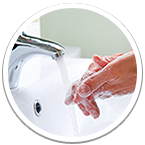Close personal contacts of a person with monkeypox
A person infected with monkeypox is considered to be infectious from the beginning of the first symptoms until the scabs have disappeared. If a person does not experience the first symptoms, their infectious period begins 1 day before the onset of skin symptoms.
Common first symptoms are fever, headache and fatigue. Skin bumps and blisters will appear 1-3 days after the onset of the first symptoms. The first symptoms may be very mild or completely absent, in which case the first symptom may only be bumps and blisters.
More information on the symptoms of monkeypox
Who are considered close contacts?
This definition applies to the current worldwide monkeypox epidemic.
As a rule, persons are considered close personal contacts if they have been in the close contact defined below with the person who has monkeypox during their infectious period (see definition above):
- Sexual contact with the person who has monkeypox (most important close personal contact group).
- Persons who have been in direct contact with monkeypox blisters or secretion from these blisters.
- People living in the same household or residing in comparable similar conditions with a person who has monkeypox based on a risk assessment.
- Factors that can influence the risk assessment include persons having had several physical contacts (such as persons who have stayed overnight in the same room) and/or persons who have worn the same clothing, or used the same bedding or objects (e.g. cutlery) as the person with monkeypox.
- Those who have cared for and treated the person with monkeypox (e.g. healthcare personnel) and have not been adequately protected. See "Protection of healthcare professionals" on the monkeypox web page.
- Health care workers may not necessarily be classified as close personal contacts, if they have used a surgical face mask when examining and treating a person who has monkeypox if the contact has been short.
- Laboratory personnel exposed to a sample containing the virus due to an accident at work.
- Other persons defined as close contacts based on a case-specific risk assessment.
- For example, people who have spent a long time (more than 3 hours) face to face (at a distance of less than 2 m) with a person who has monkeypox.
- Sexual contact with strangers. For example, an event where the person has had sexual relations with unknown persons. In this case, an effort will be made to share information with participants on the possibility of exposure through the event organiser.
Recommendations for close contact
It is important that you follow the below recommendations concerning close contact with others for a period of 21 days from the last exposure date or until the infection is otherwise excluded.
Recommended for close contacts
- Monitor the onset of symptoms daily and, if symptoms occur, contact health care by phone. Possible symptoms include fever, headache, fatigue and skin symptoms. More information on the symptoms of monkeypox.
- Observe good hand hygiene and wear a mask. It is advisable to wash your hands thoroughly and/or use an alcohol rinse.
- Refrain from sexual and other physical contact, including with family members.
- Avoid close contact with pregnant women, children and people with a severe underlying disease (immune deficiencies).
- Avoid contact with animals, especially with rodents but also other mammals and domestic animals.
The above instructions are a recommendation and there is no legal obligation to comply with them. However, compliance with the instructions is recommended as it reduces the risk of further infection and prevents the spread of the disease.




